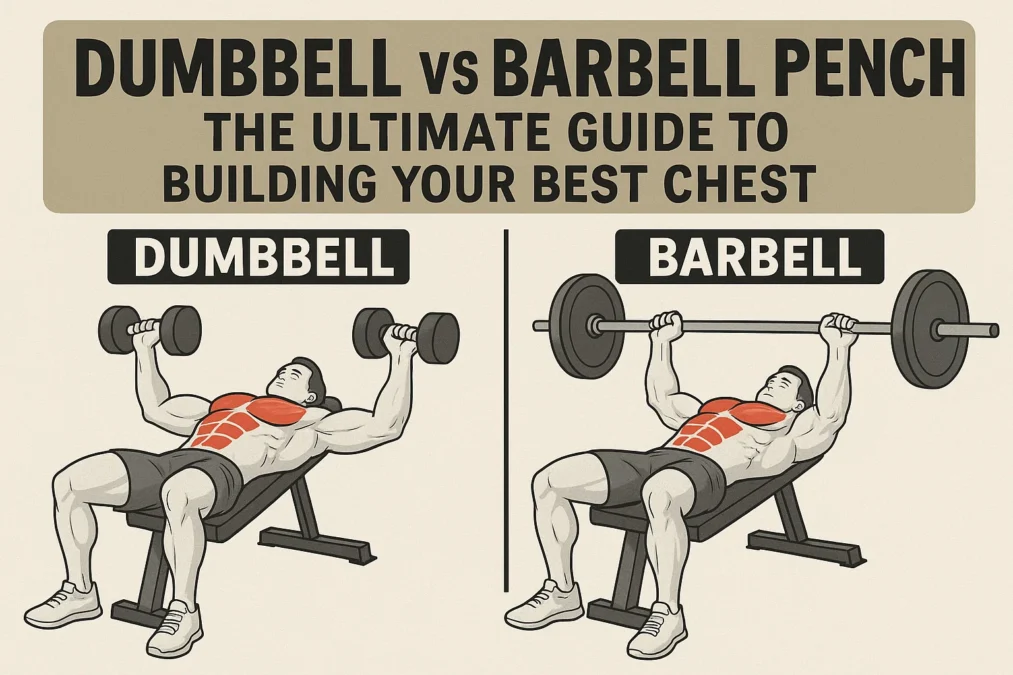You walk into any gym in the world, and you’ll see two universal symbols of strength training: the barbell, loaded with plates, sitting on a bench press station, and the dumbbells, neatly racked or being pressed by someone focused on the burn. For anyone serious about building a powerful chest, improving upper body strength, or simply enhancing their physique, the bench press is a non-negotiable cornerstone. But a fundamental question has divided lifters for decades: which is truly better for you, the dumbbell vs barbell bench press?
This isn’t just a matter of personal preference or gym lore. The choice between these two legendary exercises has profound implications for your strength numbers, your muscle growth, your joint health, and your long-term athletic development. The barbell bench press is the king of raw, measurable power, the staple of powerlifting meets, and the go-to exercise for moving serious weight. The dumbbell bench press, on the other hand, is often hailed as the superior muscle-builder, a friend to your shoulders, and a tool for achieving balanced development. But is one objectively better than the other? The answer, as you’ll discover, is a resounding “it depends.”
In this comprehensive guide, we’re going to dive deep into the world of pressing. We’ll dissect the biomechanics, the advantages, the hidden drawbacks, and the specific goals that each exercise serves best. We’ll move beyond the hype and look at the science and practical experience to help you understand not just which one to choose, but how to intelligently integrate both into your training to create a well-rounded, powerful, and resilient upper body. So, grab a seat (or a bench), and let’s settle the great debate of the dumbbell vs barbell bench press once and for all.
Understanding the Barbell Bench Press
The barbell bench press is more than an exercise; it’s an institution. It’s one of the three lifts in the sport of powerlifting, and for many, the number they can bench is a direct, if simplistic, measure of their strength. The movement itself seems straightforward—lie on a flat bench, lower a barbell to your chest, and press it back up—but the devil is in the details. The setup, the grip width, the bar path, and the leg drive all play a crucial role in performing it correctly and safely. When you unrack a loaded barbell, you are handling a single, fixed object. This stability is both its greatest strength and a potential source of limitation.
The primary appeal of the barbell bench press lies in its ability to handle maximal loads. Because the barbell is a fixed implement, your stabilizer muscles don’t have to work as hard to control the path of the weight as they do with dumbbells. This allows you to channel more of your raw force production directly into moving the load. Furthermore, the ability to incrementally add small amounts of weight (as little as 1.25-pound microplates on each side) makes it the perfect tool for progressive overload, the fundamental principle of getting stronger. You can precisely track your progress from week to week, making it a quantifiable benchmark for your strength gains. This is why the barbell bench press is often the centerpiece of strength-focused programs.
The Key Benefits of Barbell Bench Pressing
The most significant advantage of the barbell bench press is its capacity for overloading the pectoral muscles, triceps, and anterior deltoids with heavy weight. This heavy loading is a potent stimulus for strength adaptation and neurological efficiency. Your nervous system learns to recruit more muscle fibers, more efficiently, to handle the immense stress. This is something that is much harder to replicate with dumbbells, especially as the weights get heavier and the instability increases. For anyone whose primary goal is to increase their one-rep max or build a foundation of raw pushing power, the barbell is arguably unmatched.
Another often-overlooked benefit is the efficiency and convenience of the barbell bench press. Loading and unloading plates is generally quicker than hunting for the correct pair of dumbbells, especially in a busy gym. This efficiency makes it ideal for strength athletes who need to perform multiple heavy sets with specific weight percentages. Additionally, the fixed nature of the bar allows for specific technical practices, like using a false grip (though this can be risky) or varying grip widths to target different muscle emphases. A wider grip typically places more stress on the pectorals, while a closer grip turns the movement into a formidable triceps developer, blurring the lines between a bench press and a close-grip bench press.
The Drawbacks and Limitations of the Barbell Bench Press
For all its glory, the barbell bench press is not without its flaws. The most commonly cited issue is its potential for shoulder impingement. The fixed hand position forces your shoulders into a specific, internal rotation path that, for many individuals with pre-existing shoulder issues or poor mobility, can compress the tendons and bursa in the shoulder joint. This can lead to pain, inflammation, and eventually, injury. The range of motion is also fixed by the barbell itself; once the bar touches your chest, you must press it back up. For those with longer arms or a barrel chest, this might not be an optimal or comfortable range of motion.
Furthermore, the barbell bench press can promote and even exacerbate muscle imbalances. If one side of your body—say, your right pectoral or tricep—is stronger than the left, the stronger side will naturally take over to help complete the lift. The barbell doesn’t care; it moves as a single unit. Over time, this can make the strong side stronger and the weak side relatively weaker, leading to asymmetries that can affect both your physique and your injury risk. The barbell bench press is a fantastic tool, but it demands a high degree of self-awareness and often requires accessory work to correct the imbalances it can create.
Understanding the Dumbbell Bench Press
If the barbell bench press is the disciplined, quantifiable soldier of chest training, the dumbbell bench press is the agile, free-moving martial artist. This exercise requires you to control two independent weights, introducing a whole new dimension to the pressing movement. The act of just getting the dumbbells into the starting position is a feat of coordination and stability in itself. Once you’re pressing, each arm is forced to work autonomously, without any help from its counterpart. This independence is the core of what makes the dumbbell vs barbell bench press debate so interesting.
The dumbbell bench press offers a unique combination of freedom and demand. Your hands are not locked into a fixed path, allowing your shoulders to find a more natural, comfortable pressing groove. This often means you can achieve a deeper stretch at the bottom of the movement without the barbell shaft limiting your range of motion. This increased range of motion is a key factor for muscle growth, as it places the muscle under tension for a longer period and through a fuller stretch, both of which are potent stimuli for hypertrophy. The dumbbell bench press is, therefore, often considered a more “joint-friendly” and “muscle-focused” variation.
The Key Benefits of Dumbbell Bench Pressing
The most celebrated benefit of the dumbbell bench press is its requirement for balanced muscular development. Since each side must work independently, it becomes impossible for your dominant side to compensate for the weaker one. If one arm starts to falter, the dumbbell on that side will stall, providing immediate and unambiguous feedback. This makes it an excellent corrective exercise for fixing left-to-right strength and size imbalances. Over time, this leads to a more symmetrical and aesthetically pleasing physique, as well as more balanced functional strength.
Another massive advantage is the significantly greater range of motion. With dumbbells, you can lower the weights deep beside your chest, feeling a profound stretch in your pectoral muscles that is simply unattainable with a barbell. This deep stretch has been linked to greater muscle damage and subsequent growth. Furthermore, the free-moving nature of the dumbbells allows your wrists, elbows, and shoulders to rotate into a more natural and comfortable position throughout the movement. This can drastically reduce the stress on the shoulder joint, making the dumbbell bench press a safer and more sustainable option for many lifters with shoulder pain.
The Drawbacks and Limitations of the Dumbbell Bench Press
The primary drawback of the dumbbell bench press is its limitation in absolute strength development. The very instability that makes it so good for building stabilizer muscles also prevents you from lifting as much total weight. Your body has to dedicate a significant amount of neural drive and energy to simply controlling the path of the dumbbells, which takes away from the pure force you can apply to the press. You will always be able to bench press more weight with a barbell than you can with two dumbbells of equivalent combined weight.
There is also a practical issue of convenience and progression. In most commercial gyms, dumbbells only go up to a certain weight, often capping at 100 or 150 pounds. This can put a hard ceiling on your progress if dumbbells are your primary pressing tool. Moreover, progressing is less granular. You typically have to jump in 10 or 15-pound increments (e.g., from 80s to 90s), which is a 20 to 30-pound total jump. This can be too large a jump to make consistently, potentially stalling your progress. Finally, just getting heavy dumbbells into position can be a challenge and a injury risk in itself, often requiring a smart “kick-up” technique or a spotter’s assistance.
Head-to-Head Comparison: Key Performance Factors
When you strip everything back, your fitness goals should be the ultimate deciding factor in the dumbbell vs barbell bench press debate. Each exercise excels in different areas, and understanding these nuances will allow you to tailor your training for maximum results. Are you training to be as strong as possible, to look as muscular as possible, or to be as resilient and injury-free as possible? The answer to that question will point you toward your ideal primary pressing movement, though, as we will see, the most intelligent approach is rarely one of absolute exclusion.
Lagree vs Pilates: The Ultimate Guide to Choosing Your Low-Impact Fitness Path
For pure, measurable, maximal strength, the barbell bench press is the undisputed champion. If your goal is to increase your one-rep max, compete in powerlifting, or simply feel the raw power of moving massive weight, the barbell is your tool. The specificity of the movement—training your nervous system and muscles to handle a heavy, fixed bar—is irreplaceable. The dumbbell vs barbell bench press for strength isn’t much of a contest when it comes to the top end. However, dumbbells can play a crucial role in building the foundational strength and muscle mass that will support your barbell numbers in the long run.
Muscle Growth and Hypertrophy
When it comes to building muscle, the debate gets far more interesting. While the barbell allows you to move more total weight—a key driver of hypertrophy—the dumbbell offers a greater range of motion and a better stretch, which are also critical for growth. Many elite bodybuilders and coaches believe the superior stretch and the need for individual limb control make the dumbbell bench press a marginally better pure bodybuilding exercise for the chest. It places a unique type of stress on the muscle fibers that can lead to growth in ways the barbell cannot.
That said, to dismiss the barbell bench press as inferior for hypertrophy would be a mistake. The ability to systematically overload the muscles with progressively heavier weight is a cornerstone of muscle building. A well-executed barbell bench press program will undoubtedly build a thick, powerful chest. The most effective strategy for most people is not to choose one over the other, but to use them in conjunction. You might use the barbell for your heavy, strength-focused work and the dumbbell for your higher-rep, hypertrophy-focused accessory work. This dual approach ensures you’re stimulating muscle growth through multiple mechanisms.
Stability and Joint Health
This is arguably the category where the dumbbell bench press shines the brightest. The freedom of movement afforded by dumbbells is a godsend for shoulder health. Your shoulders can naturally retract and slightly externally rotate during the descent, moving in a path that is anatomically more friendly and less likely to cause impingement. For lifters with a history of shoulder pain, switching to dumbbells often provides immediate relief and allows them to continue training hard without aggravating old injuries.
The barbell bench press, with its fixed internal rotation path, is notoriously hard on the shoulders for many individuals. This doesn’t mean it’s inherently bad, but it does mean that proper form is non-negotiable. Techniques like retracting the scapula (pulling your shoulder blades back and down) creating a slight arch in the upper back, and tucking the elbows can make the barbell bench press much safer. However, for those with significant mobility issues or chronic pain, the dumbbell variation is almost always the safer and more sustainable choice in the long-term dumbbell vs barbell bench press consideration for joint health.
Correcting Imbalances and Unilateral Training
The dumbbell bench press is the clear winner when it comes to identifying and correcting muscular imbalances. As mentioned, the independent nature of the lift forces each side to pull its own weight. If you consistently find that one arm struggles more than the other during your dumbbell sets, you have a clear diagnostic of an imbalance. You can then address this by incorporating even more unilateral work, like single-arm dumbbell presses or chest-supported rows for the back.
The barbell bench press, while excellent for building gross strength, can mask these imbalances. You might be able to press a significant amount of weight, but if film reveals one side of the bar moving faster or higher than the other, it’s a sign of an imbalance that the barbell itself is allowing to persist. A smart training program will use dumbbell work as a supplement to a barbell-focused program precisely for this corrective and balancing effect. It ensures that your strength is not just a number on the bar, but a quality possessed equally by both sides of your body.
How to Integrate Both for the Perfect Chest Routine
The most effective approach to the dumbbell vs barbell bench press dilemma is to stop seeing it as an “either/or” question and start seeing it as a “when and how” strategy. The wisest lifters understand that these two exercises are not rivals, but powerful allies that work in synergy. By periodizing your training and intelligently rotating your exercise selection, you can harvest the unique benefits of each while minimizing their respective drawbacks. This holistic approach leads to more sustainable progress, a more resilient physique, and a more well-rounded athletic profile.
A classic and highly effective method is to structure your training in blocks or phases. For example, you might run a 6-8 week strength block where the barbell bench press is your primary movement. You would train it heavy for lower repetitions (e.g., 3-5 reps per set), focusing on adding weight to the bar each week. During this phase, the dumbbell bench press could serve as a secondary, higher-rep accessory movement (e.g., 8-12 reps) to build muscle mass and address imbalances. This allows you to pursue peak strength without completely neglecting the hypertrophy and stability benefits of dumbbells.
Sample Training Splits and Exercise Sequencing
Another intelligent approach is to alternate your primary pressing movement from one workout to the next, or from one training block to the next. For instance, in an “Upper Body A / Upper Body B” split, your “A” day could be built around the barbell bench press for strength, while your “B” day could be built around the dumbbell bench press for hypertrophy and muscle focus. This provides variety and constantly challenges your muscles in slightly different ways, which can help break through plateaus.
Exercise sequencing is also critical. If your goal is maximal strength on the barbell bench press, it should always be the first exercise you perform when you are fresh and strong. Conversely, if you are focusing on muscle growth with dumbbells, you could pre-exhaust your chest with flyes or cable crossovers before moving to your dumbbell presses, forcing your pectorals to do more of the work. There is no single perfect routine, but the principle is clear: prioritize the exercise that aligns with your primary goal for that session, and use the other as a valuable supplement to cover the weaknesses of the first.
A Detailed Comparison Table
| Feature | Dumbbell Bench Press | Barbell Bench Press |
|---|---|---|
| Primary Strength | Superior for stabilizer strength and unilateral control. | Superior for absolute, maximal strength and 1-rep max. |
| Muscle Growth | Excellent, due to greater range of motion and stretch. Can be better for pec development. | Excellent, due to ability to handle heavier loads. A proven mass-builder. |
| Stability Demand | High. Requires significant stabilizer muscle engagement. | Low. The bar is fixed, allowing focus on prime movers. |
| Range of Motion | Greater. Allows for a deeper stretch at the bottom. | Limited. Bar contact with the chest defines the bottom. |
| Joint Health | Generally more shoulder-friendly due to natural movement path. | Can be harsh on shoulders; requires impeccable form to be safe. |
| Correcting Imbalances | Excellent. Forces each side to work independently. | Poor. Can mask and even exacerbate muscle imbalances. |
| Progression | Less granular. Often requires 5-10 lb jumps per dumbbell. | Highly granular. Can add small increments (e.g., 2.5 lbs total). |
| Convenience & Setup | Can be awkward with heavy weights; requires a “kick-up” technique. | Generally easier to set up and unrack, especially with a spotter. |
Wisdom from the Iron Game
“The barbell measures your strength, but the dumbbell reveals it.” – Anon.
This popular gym quote captures the essence of the dumbbell vs barbell bench press debate perfectly. The number on the barbell is a clear, objective measure of your pressing power. However, your ability to control heavy dumbbells, maintain balance, and achieve a full range of motion reveals a different, more nuanced kind of strength—one of stability, control, and muscular maturity.
“A champion is built with both the barbell and the dumbbell. One for the foundation, the other for the finish.” – Common Coaching Philosophy.
This sentiment reinforces the idea of integration. The barbell is your primary tool for building a foundation of raw strength and power—the skeleton of a powerful physique. The dumbbell is the tool you use to refine that physique, to carve out detail, correct imbalances, and ensure that the strength you build is functional and sustainable. They are two sides of the same coin, both essential in the pursuit of a complete athletic development.
Conclusion
The great dumbbell vs barbell bench press debate doesn’t have a single winner, because the true winner is the lifter who understands how to use both tools effectively. The barbell bench press reigns supreme for building raw, quantifiable strength and overloading the muscular system with heavy weight. It is the cornerstone of powerlifting and a proven mass-builder. The dumbbell bench press, with its superior range of motion, inherent demand for stability, and ability to correct imbalances, is a master tool for hypertrophy, joint health, and creating a balanced, resilient physique.
Your journey shouldn’t be about picking one and ignoring the other. Instead, let your goals dictate your focus. If you’re a strength athlete, the barbell will be your main lift, supported by dumbbell work. If you’re a bodybuilder or someone focused on general fitness and joint health, dumbbells might take a more prominent role, with barbell work used for periods of strength emphasis. The most powerful chests in the world are built not by allegiance to one piece of equipment, but by a smart, periodized, and synergistic use of both the dumbbell and the barbell bench press. So, embrace the duality, and watch your chest development reach new heights.
Frequently Asked Questions
Which exercise is better for a complete beginner?
For a complete beginner, the dumbbell bench press often has a slight edge. It teaches each side of the body to work independently from the start, preventing the development of significant imbalances. It also allows for a more natural range of motion, which is gentler on the shoulder joints as a new lifter learns proper pressing mechanics. The need to stabilize the weights also builds a solid foundation of supporting muscle strength. However, learning the barbell bench press with light weight and perfect form is also highly valuable. A great approach is to start with dumbbells to build a base and then gradually introduce the barbell.
Can I build a big chest using only dumbbells?
Absolutely. You can build an impressive and massive chest using only dumbbells. The key to muscle growth is progressive overload—consistently increasing the stress on your muscles over time. With dumbbells, you can achieve this by lifting heavier weights, performing more repetitions, increasing your sets, or reducing your rest time. The deep stretch provided by the dumbbell bench press is a phenomenal stimulus for pectoral growth. While you may eventually be limited by the highest-weight dumbbells available in your gym, for the vast majority of lifters, the dumbbell alone provides more than enough resistance to build a substantial chest.
Why can I lift more with a barbell than with dumbbells?
This is entirely normal and comes down to physics and neurology. With a barbell, you are moving a single, stable object. Your stabilizer muscles (like the rotator cuff and smaller shoulder muscles) don’t have to work as hard to control the weight’s path. This allows your prime movers—your pecs, triceps, and delts—to dedicate almost all their energy to producing upward force. With dumbbells, a significant amount of your neural drive and strength is diverted to controlling the independent movement of each weight. This instability is why the combined weight of two dumbbells will always be less than your one-rep max with a barbell.
How can I make the barbell bench press safer for my shoulders?
Making the barbell bench press safer hinges on proper setup and technique. First, focus on retracting and depressing your scapula—pull your shoulder blades back and down as if you’re trying to hold a pencil between them. This creates a stable shelf for you to press from. Second, avoid flaring your elbows out at a 90-degree angle; instead, tuck them at a 45-60 degree angle relative to your torso. This reduces internal rotation and shoulder impingement risk. Third, ensure you have a slight arch in your upper back. Finally, consider using a grip width that allows your forearms to be vertical at the bottom of the movement, which is typically most efficient and safest.
Should I do dumbbell and barbell bench presses on the same day?
You can, but it requires smart programming. It’s generally not advisable to perform both as heavy, primary lifts in the same session as this would lead to excessive fatigue and poor performance on the second exercise. A better approach is to make one the “primary” lift and the other the “accessory” lift. For example, you could perform 3-4 heavy sets of barbell bench press for 3-5 reps, rest adequately, and then move to 3 sets of dumbbell bench press for 8-12 reps as a hypertrophy-focused supplement. Listen to your body; if your performance drops dramatically on the second exercise, you may be better off splitting them across different workouts.



